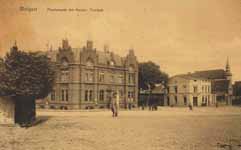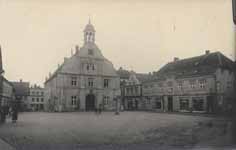.




4, 5, 6,
7, 8, 9, 10, 11, 12,
Wolgast
Wolgast (German pronunciation: [ˈvɔlɡast]) is a town in the district of Vorpommern-Greifswald, in Mecklenburg-Vorpommern, Germany. It is situated on the bank of the river Peenestrom, vis-a-vis the island of Usedom that can be accessed by road and railway via a bascule bridge (Blaues Wunder). In December 2004, the town held a population of 12,725.
History
St.Petri
Palace, 1652
The precursor of present-day Wolgast was a Wendish stronghold, the fort Hologast (alt. Wołogoszcz, Ołogoszcz). In 1123, Hologast surrendered to the Pomeranian duke Wartislaw I. In 1128, the Wends were baptized by Otto of Bamberg, who destroyed a local Gerowit temple and set up the St-Petri Church at that site.[2] German settlers populated the growing town soon after, and the city of Wolgast was granted Lübeck law by Wartislaw III in 1282.[3]
Wolgast was residence of the Pomeranian dukes from 1285 until the ruling House of Pomerania went extinct in 1637.[2] Capital of Pomerania-Wolgast, a longtime inner partition of the duchy, a residential palace was built in Renaissance style on an island hence called Schloßinsel (palace island).[3] The ducal line of Pomerania-Wolgast went extinct when Philipp Julius died without issue.[4]
During the Thirty Years' War, the Swedish Empire occupied Wolgast in 1630 and kept it as a part of Swedish Pomerania until 1815. The former ducal palace decayed, and the town was burned down in 1713 by Russian forces during the Great Northern War, in retaliation for Swedish arson in Altona.[2] Only the church, four chapels and four more buildings were spared by the fire.[2] Most houses of the Old Town therefore date back to the 18th and 19th centuries,[3] the townhall was renewed after the fire in baroque style.[2]
After the Swedish withdrawal from Pomerania in 1815, the city was integrated into the Prussian Province of Pomerania. Last remnants of the palace were removed in 1849.[3] Wolgast prospered throughout the 19th century as a port for grain trade.[2]
Wolgast lost its status as a Kreis capital on June 12, 1994, when Kreis Wolgast was merged into Kreis Ostvorpommern, which became part of Vorpommern-Greifswald in 2011.
Museums
The town's history is presented in the Stadtgeschichtliches Museum (Towns' historical museum) in a building at the market place nicknamed Kaffeemühle.[3] The former house of painter Phillip Otto Runge is also a museum by now (Rungemuseum).[3]
References
^ "Bevölkerungsstand der Kreise, Ämter und Gemeinden in Mecklenburg-Vorpommern 31.12.2010" (in German). Statistisches Amt Mecklenburg-Vorpommern. 6 July 2011.
^ a b c d e f Berger (2008), p.361
^ a b c d e f Dubilski (2003), p.173
^ Wolgast (1995), p.217
Bibliography
Dubilski, Petra (2003) (in German). Die Ostseeküste : Mecklenburg-Vorpommern (2 ed.). DuMont. ISBN 3770159268.
Wolgast, Eike (1995) (in German). Hochstift und Reformation: Studien zur Geschichte der Reichskirche zwischen 1517 und 1648. F. Steiner. ISBN 3515065261.
Berger, Christine (2008) (in German). Mecklenburg-Vorpommern (7 ed.). Baedeker. ISBN 3829710623.
From Wikipedia, All text is available under the terms of the GNU Free Documentation License
